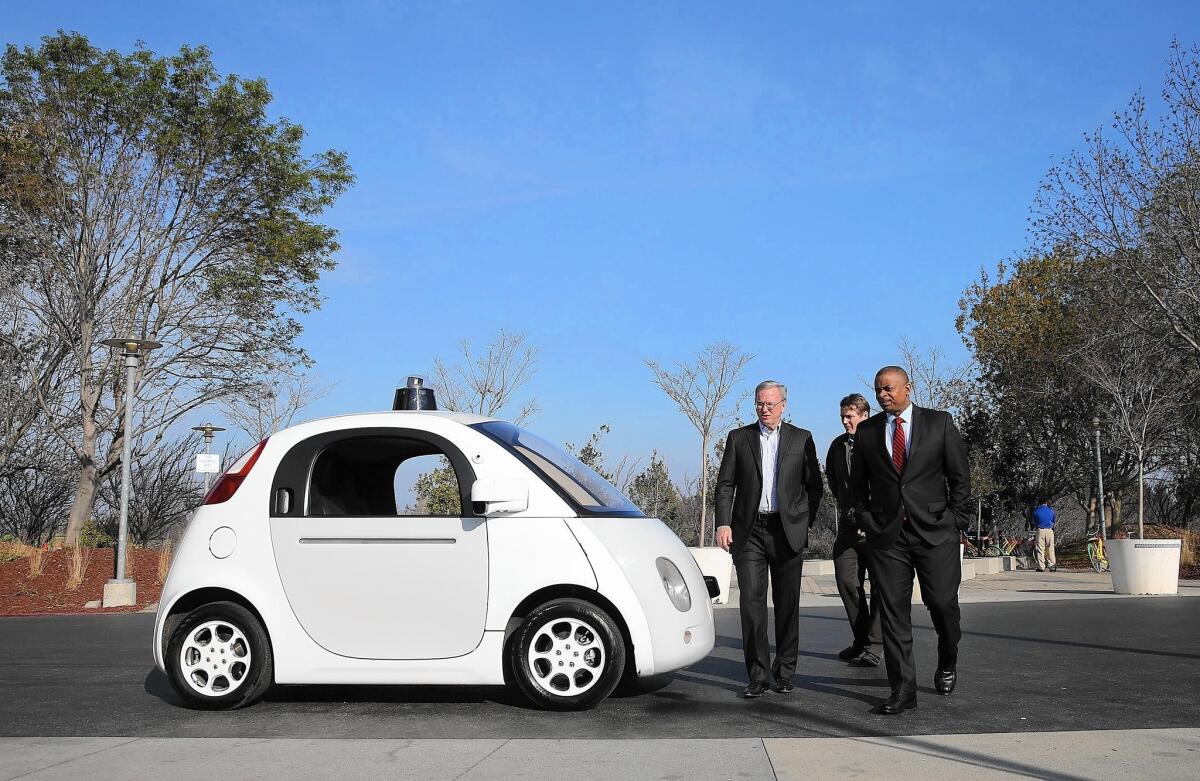The Download: How can we make sure that driverless cars are safe?

Google Chairman Eric Schmidt, left, and U.S. Transportation Secretary Anthony Foxx, right, walk around a Google self-driving car at the company’s headquarters in Mountain View, Calif.
- Share via
Ready or not, the robots are coming. There will be cars driving themselves, with no steering wheel for us to grab. Delivery drones will maneuver around patio furniture and vegetable gardens to drop packages in backyards. Delivery carts on sidewalks will hum along, bringing pizza boxes to our front doors.
These systems will operate without any humans directly keeping an eye on them. This raises a huge question that everyone from government regulators to tech companies and safety advocates are wrestling with. If robots are driving us around, delivering our meals, baby-sitting the elderly, replacing doctors in operating rooms and fighting in wars, can we trust them to behave safely?
“This is the most essential question of the whole matter,” said Andrew Platzer, who researches car, aircraft and robotic safety at Carnegie Mellon University. “It’s a very difficult question, how you can know for sure that the system itself is actually really safe.”
The emerging presence of robotics is happening in a wide range of disparate fields, so these innovations are largely falling into a regulatory black hole, challenging the way our society is set up to evaluate safety.
For example, should driverless cars be regulated by state DMVs or the U.S. Department of Transportation — both of which lack deep knowledge of robotics? What about military robots — should the United Nations develop rules or should each government go its own way? Some are calling for a new government agency in the United States, kind of like a NASA for robots, because traditional agencies lack expertise in the rapidly emerging field.
“The government itself is not acting as a repository of expertise here,” said Ryan Calo, a law professor at the University of Washington and expert on technology policy. “I worry quite a bit that government will over-rely on experts from industry because they don’t have their own internal knowledge.”
Some states have already started testing autonomous cars on their roads. They see the potential safety benefits these vehicles can bring and want to attract jobs and businesses. But while officials in these places stress safety as a priority, none have explained in detail how to determine that a robot is safe enough.
California is ahead of most states in addressing these issues. Last week the California Department of Motor Vehicles released draft guidelines for autonomous cars but refrained from addressing fully autonomous vehicles, which don’t require a driver, steering wheel or pedals. The DMV says it will tackle self-driving cars down the road. The incomplete rules came more than 11 months after the department’s deadline.
The DMV is facing an extremely difficult task. It has no history of dealing with the complex algorithms that govern self-driving vehicles. Its experience has been with human drivers, not robots.
The DMV’s cautious pace has drawn some criticism. Google said Wednesday that it was “gravely disappointed,” and that the aim of its program is to improve safety on roads. Google’s cars are programmed to take a conservative approach if they see an object or situation they can’t categorize. If something crazy is happening ahead, the car is likely to stop. California Lt. Gov. Gavin Newsom warned last week that the rules might be too onerous and block innovation.
John Simpson, director of the Consumer Watchdog Privacy Project, believes that the DMV has acted admirably, given safety concerns over robotics systems.
Meanwhile, the U.S. Department of Transportation, which declined to comment on California’s rules, has focused most of its efforts on a narrow slice of robotic safety. It is addressing communication signals between autonomous vehicles, but not the broader question of determining if these robot cars will be safe.
Calo, the University of Washington professor, envisions a government group that specializes in robotics and advises agencies around the country that are struggling with related issues. He describes it as a “NASA for everything,” given the space agency’s track record of attracting exceptionally bright minds.
Mike Wagner, a Carnegie Mellon robotics researcher, tests the software behind autonomous vehicles. Although he is a believer in the overall improvements autonomous technology will bring, he cautioned that such systems will be imperfect, like the humans who build them.
“Developers are human beings that are being asked to build something extraordinary that’s never been built before,” Wagner said. “Everyone’s getting hacked. Even the smart guys get hacked. The smart guys are the ones that are like, ‘We’re going to get hacked, what should we do about it when it happens?’ ”
Matt McFarland is editor of Innovations at the Washington Post.






